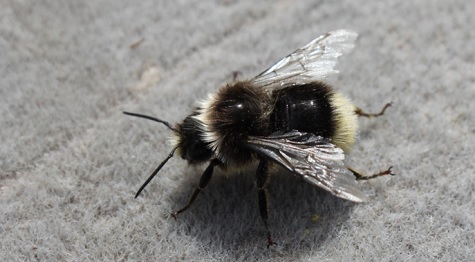It seems from a recent report seen on the BBC that the number of bumblebees across several countries have declined by a third since the 1970’s.
The article said that "Climate chaos" has caused widespread losses of bumblebees across continents, according to scientists. Climbing temperatures will increasingly cause declines, which are already more severe than previously thought, said researchers.
Bumblebees are key pollinators of many fruits, vegetables and wild plants. Without them, some crops could fail, reducing food for humans and countless other species.

Photo courtesy of Pat Callaby
The BBC report quotes researcher Peter Soroye of the University of Ottawa in Canada, who says bumblebee declines are already more severe than previously thought. "We've linked this to climate change - and more specifically to the extreme temperatures and the climate chaos that climate change is producing," he says in the piece.
Bumblebees are among the most important plant pollinators. Declines in range and abundance have been documented from a range of causes, including pesticides, disease and habitat loss.
In the new study, researchers are said to have looked at more than half a million records of 66 bumblebee species from 1901 to 1974 and from 2000 to 2014.
They found bumblebee populations declined rapidly between 2000-2014: the likelihood of a site being occupied by bumblebees dropped by an average of over 30% compared with 1901-1974.
The BBC quotes Jonathan Bridle and Alexandra van Rensburg of the University of Bristol as describing the findings as "alarming". Commenting in the journal Science, they said, "The new study adds to a growing body of evidence for alarming, widespread losses of biodiversity and for rates of global change that now exceed the critical limits of ecosystem resilience."
There are around 250 species of bumblebee in the world. According to the International Union for Conservation of Nature (IUCN), declines have been documented in Europe, North America, South America, and Asia, caused by a variety of threats that range from habitat loss and degradation to diseases and pesticide use.
So what can we do about it?
As we all know, we do not have control of the weather, however we all can certainly influence and increase the bio-diversity of the land we manage to improve the welfare of the insects, birds and mammals who populate our wonderful countryside and urban landscapes.

Over the years we have seen many initiatives from Syngenta, Bayer, Monsanto, BIGGA, R&A, STRI and numerous national countryside and wildlife governing bodies, coupled with the good work done by estates managers, greenkeepers and groundsmen across the country to preserve and promote successful ways of managing habitats for wildlife.
In the scheme of things though, the actual amount achieved to date is nowhere near enough to help change the demise of these precious insects, birds and mammals. We need to do more.

I am sure all of us who work in the sports turf and amenity sector, who are in fact the curators and managers of these priceless land assets, really need to encourage more investment into the management and maintenance of diversity of these irreplaceable land assets.

Whatever type of facility you manage there is always an opportunity to enhance and improve the diversity of your site. In recent years we have seen a number of local authorities who, due to budgetary cuts, have had to reduce their number of grass cutting operations. Long grass management regimes have been implemented, along with introducing wildflower meadows within their road islands, verges and in public parks. We are also seeing schools and many other sports facilities, including golf courses, taking on the mantle of introducing and maintaining wild flower areas.
In reality, it is about changing our mindset towards bio-diversity and the way we manage our land spaces. More importantly, we need to have a better understanding of the values and intricacies of the power of nature and its variety of needs in terms of supporting wildlife. We often forget or take for granted the knowledge we can learn from managing such a diverse landscape that includes the looking after playing surfaces, woodlands, SSSI Sites, trees, hedges, ponds, lakes, canals, rivers, marshland, coastline, sand dunes and rocky outcrops.
With so much talk about climate change, it is now time to stop the talking and get on with grasping the nettle and delivering a more inclusive landscape. The starting point is to really have a better understanding of what wildlife you have on your own doorstep and how you can increase the diversity of the land you manage. This should be done by conducting surveys of what birds, insects and mammals are living and visiting your site. Once we have this data, we can then action a plan to facilitate and manage their needs and requirements.

I visit many different sporting facilities, parks and public open spaces in my roles as editor, Green Flag judge and pitch advisor and see that there are many opportunities to implement and increase the bio-diversity of these sites.
This can be achieved by changing grass mowing regimes, creating both annual and perennial meadow areas, planting more trees and scrub, introducing beehives, bird boxes, log piles and creating some water features.
There are plenty of good examples of work that many are doing in the professional sectors particularly with golf courses, local authorities and private school sites. However, I believe there is a great opportunity for many other community and grassroots sports facilities, parish councils, state schools and large private housing developers to commit to this valuable cause.